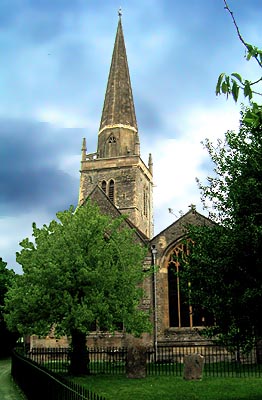 |
 |
|||
|
|
St. Helen’s Church overshadows St. Nicholas’ at Abingdon in the same way that the town’s old abbey church must have overshadowed St. Helen’s in its day. It is a huge building with a beautiful tapering spire, not a particularly common sight in medieval Berkshire. The view of Abingdon from across the Thames wouldn’t be nearly so picturesque without it. It is said to be the second widest church in England (the widest being in Hull), for it has four aisles lining the nave instead of the usual two. The size is not obvious from the outside, hemmed in as it is by the Thames and several fine sets of almshouses, notably Christ’s Hospital (or Long Alley) of 1446 with its covered corridor and pretty copula. The site has an early history, for it was almost certainly here at ‘Helenstow’ that Lady Cilla founded a nunnery as a twin to her brother’s foundation at the abbey in the 670s. Years later, the ‘Black Cross’ found in her grave was believed to contain a nailfrom the cross on which Christ was crucified. It was a great draw to pilgrims, but was removed to the abbey. Legends of a still earlier foundation by St. Helen, the mother of the Emperor Constantine can almost certainly be dismissed, although Constantine did spend time in Britain. It was St. Helen dug up the original Holy Cross in the Middle East, and some say that’s how a small part of it ended up with Cilla. An early appearance by St. Birinus on the site has also been suggested and is not impossible. St. Helen appears in a very bright modern window, not to everyone’s taste, in the south aisle. She appears again, in only slightly preferable Victorian glass – along with St. Edmund of Abingdon (who was born a few streets away) – in the Lady Chapel. Most of the present building is 15th century, but the tower is two hundred years earlier. Adjoining it is an unusual priest’s house and then the porch, with a room above used for meetings of the Fraternity of the Holy Cross based here. This was a powerful religious guild which, at the Reformation, re-emerged as the trustees of Christ’s Hospital. The northern Jesus Aisle is now a baptistery, dominated by the superb monument to Elizabeth Hawkins. One of the best in the county, it features a seated Elizabeth resting against a medallion portrait of her fiancé. Busts of her sister, cousin and parents surround her. The rococo strigillations behind are quite beautiful. The nearby font is a Victorian copy of the finely carved Norman font in Sutton Courtenay Church. It was displayed at the 1851 Exhibition. Adjoining it is the bizarre heraldic monument (from which a bread dole was once issued) to John Royse who founded Abingdon School in 1563 and a rare painted board of 1637 showing the family tree of Mayor William Lee who left 197 descendants at the time of his death! Elsewhere, another Tudor heraldic board commemorates a local MP, Oliver Hyde, one of the widespread Hyde family from Denchworth. Brasses include one to Geoffrey Barbour (1417), rescued from the dissolved abbey by his Fraternity. Royse’s monument lies beneath an archway to the Lady Chapel in the Lady Aisle. This was built by another religious guild, that of Our Lady, and here once stood the statue of Our Lady of Abingdon, pilgrims to which Pope Boniface IX granted an ‘indulgence’ promising four years’ relief from purgatory. Shortly afterwards, perhaps in 1392, the guild commissioned a wonderful painted ceiling for the chapel, showing a ‘Jesse Tree’ of Jesus’ ancestry. Look upwards, for it still survives today as the great treasure of St. Helen’s. There are fifty-two panels showing the same number of biblical characters within carved gothic arches, all backed in vibrant red and some almost as complete as the day they were painted. The Mayor’s pew is also here, with an iron stand for the Civic Mace. On the other side of the nave is St. Katherine’s Aisle and then the southern Reade Aisle, named after the Reades from Barton Court on the edge of the parish, although there are no monuments to them. It was built by the widow of the last steward of the abbey in 1539. This is not the official St. Helen's Church website. Please do NOT mail me about use of the church. Visit the C of E's Church Near You website instead.
|
|||
| © Nash Ford Publishing 2010. All Rights Reserved. The location of this church is now administered by Oxfordshire County Council. | ||||



 Abingdon
Abingdon